Share this
The Birth of a Trenton System: How We Build Our Rugged Computers
by Brett Daniel on Aug 19, 2020 1:50:42 PM
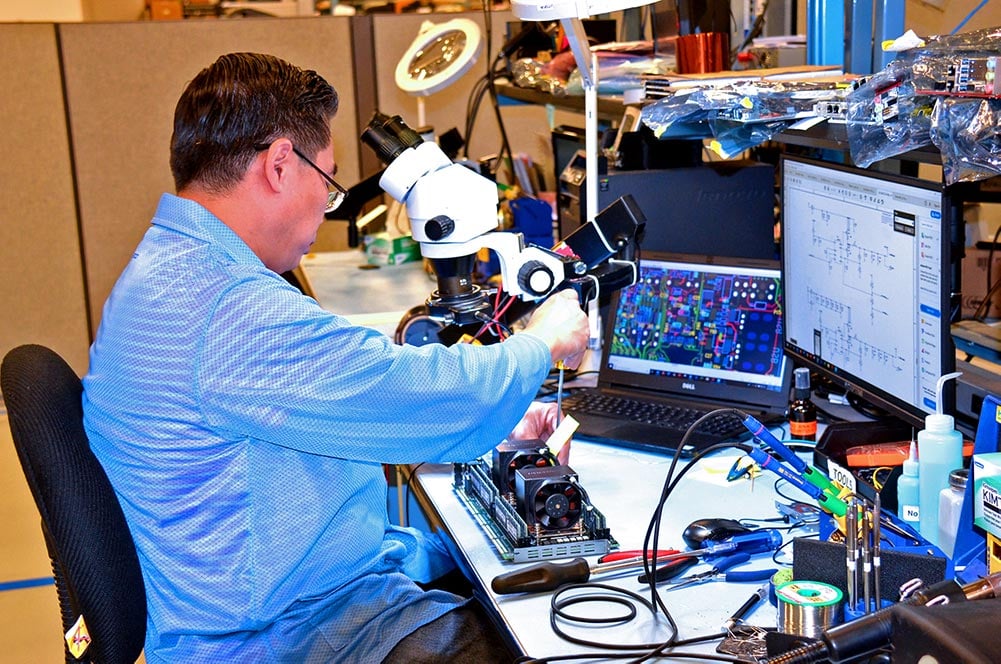
Photo: A Trenton Systems employee installs system components onto a Trenton Systems SEP8253 processor board.
Every morning, Trenton Systems’ production floor rings, rumbles and hums with productivity. This unmistakable series of sounds is the result of dozens of Trenton employees assembling, testing, inspecting, packaging, and shipping numerous TS rugged servers, blade servers, workstations, mini PCs, storage systems and their various system components.
But how exactly do we do it?
Well, one thing's for sure, it's a relatively fast process. Our average lead time, from the moment a purchase order is received to the day it’s shipped to the customer, is between five and six weeks, but once a system begins its journey on the production floor, it can take just five days to complete, sometimes sooner, sometimes later, depending mostly on testing and any unforeseen modifications.
Trenton Systems is one of the only computer hardware companies that designs, assembles, integrates, tests and supports its rugged computers in-house, in the USA.
Because of our unique place in the rugged computing industry, we often receive a request for a facility tour, or a phone call, live chat or email asking us how our production process works and how we manufacture our military computers, industrial computers and their components.
The short answer is that every system is different; one of our systems will not have the same production journey as another. There is a standard process, however, that most of our commercial-off-the-shelf rugged computers undergo.
So, you asked about our production process, and we're answering.
We followed one of our systems through the entire production process recently to show you exactly how it’s done. We also outlined potential paths that one of our rugged computers could take during the process, based on customer requirements.
From the initial purchase order to shipment, this is how we build our rugged computers in seven steps:
- Discussion & Decision-Making
- Design
- Manufacturing
- Sub-Assembly & Assembly
- Testing & Ruggedization
- Quality & Shipment
- Support
Target System: TMS4711
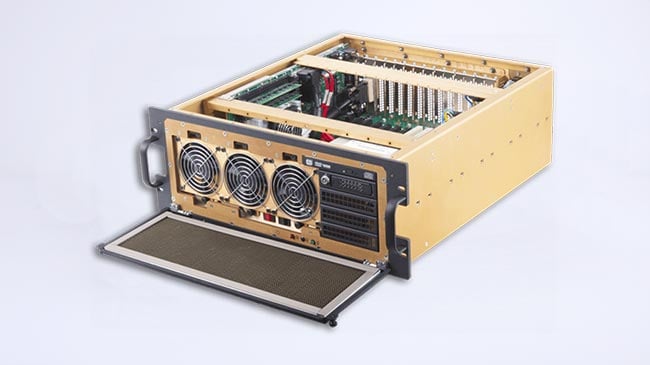
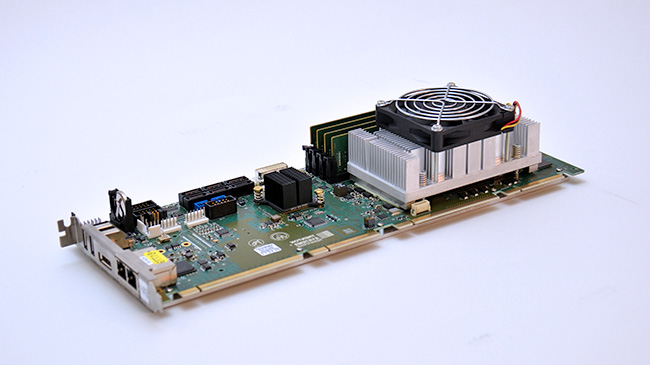
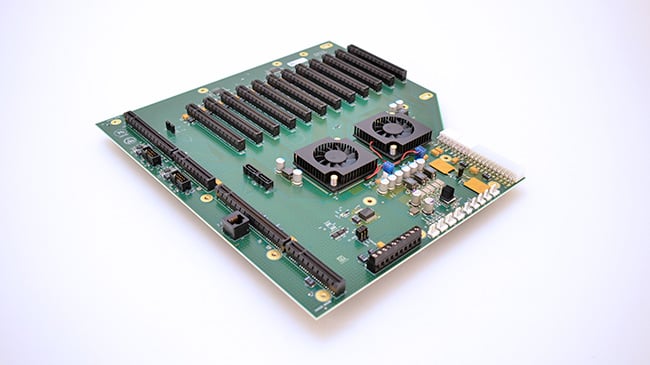
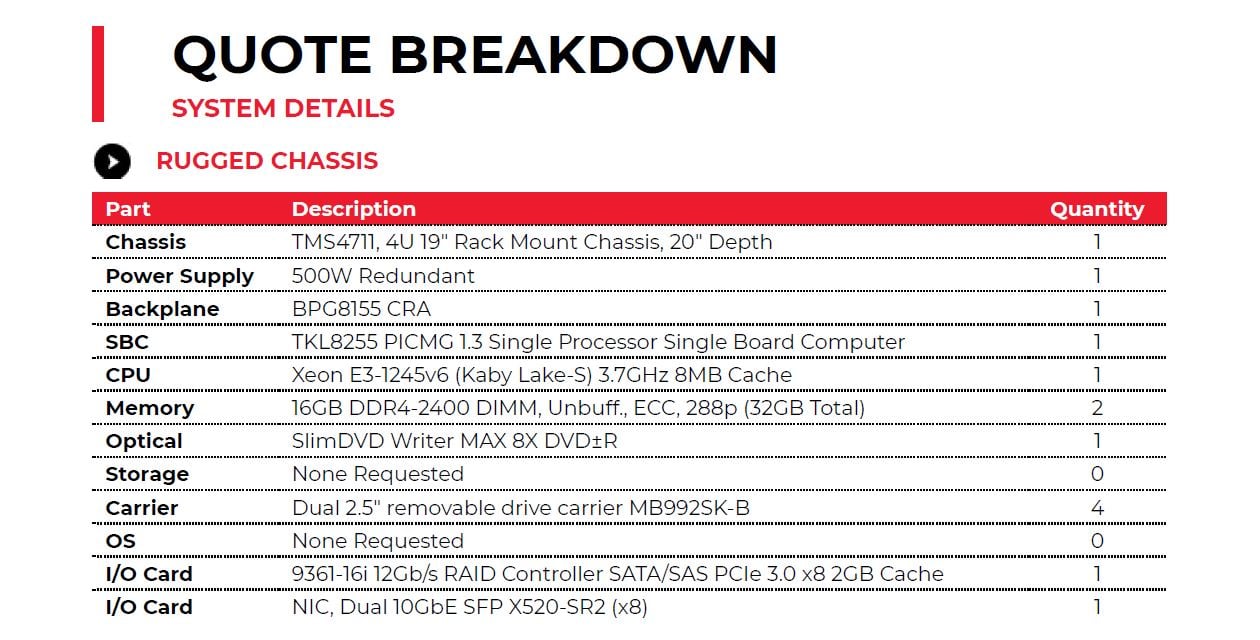
Table: To demonstrate the typical production journey of a TS rugged computer system, we followed a TMS4711 rugged workstation with a TKL8255 processor board and BPG8155 backplane through production from the moment we received the purchase order. See the quote breakdown above for a complete list of the system's specifications.
Discussion & Decision-Making
During the discussion and decision-making phase, a customer reaches out to Trenton Systems to discuss a rugged computing solution for their military, industrial or commercial program or application.
In the case of the TMS4711 system we followed, a first-time Trenton customer reached out to us in June of 2020 and asked us to build the system with the following specifications:
- TKL8255 processor board
- BPG8155 PCIe backplane
- Intel Xeon E3-1245v6 CPU
- Two 16GB DDR-2400 DIMM slots with ECC memory
- Optical DVD drive
- 2.5" removable drive carrier
- RAID I/O card
- Network interface I/O card
This system would eventually be tested and integrated into a larger system by the United States military for video surveillance purposes. The customer asked us not to install SATA SSDs, NVMe SSDs, or even an operating system, as they wanted to install their own. Our lead time was approximately six weeks.
Customers can reach out to us to discuss these types of specifications using a few different avenues. Our larger military, industrial, government and commercial customers often contact us via a request for information (RFI), request for quote (RFQ), or request for proposal (RFP), depending on what stage of the procurement process they’re in, while other customers typically connect with us via live chat, email or phone to ask general questions or discuss potential requirements and specifications for a solution that interests them.
The information derived from the discussion and decision-making phase helps our sales and engineering team craft the perfect solution for the customer. Customer requirements and specifications vary greatly, depending on the type of system, the atmospheric or environmental conditions of its end environment, the software or applications it’s expected to support, the space or area in which it is expected to fit, and of course, whether the system is a standard COTS solution or fully customized from the board up.
Once a customer is satisfied with a proposed solution and wishes to move forward with a purchase, they send Trenton Systems a purchase order and a lead time. From there, the customer’s system begins its official journey to completion, which can begin in a few different ways.
In the case of the TMS4711 we followed, it began with sub-assembly and assembly, so skip to that section if you want to know more about this specific system. Otherwise, keep reading to learn more about how our production process tackles customized purchase orders in the design phase.
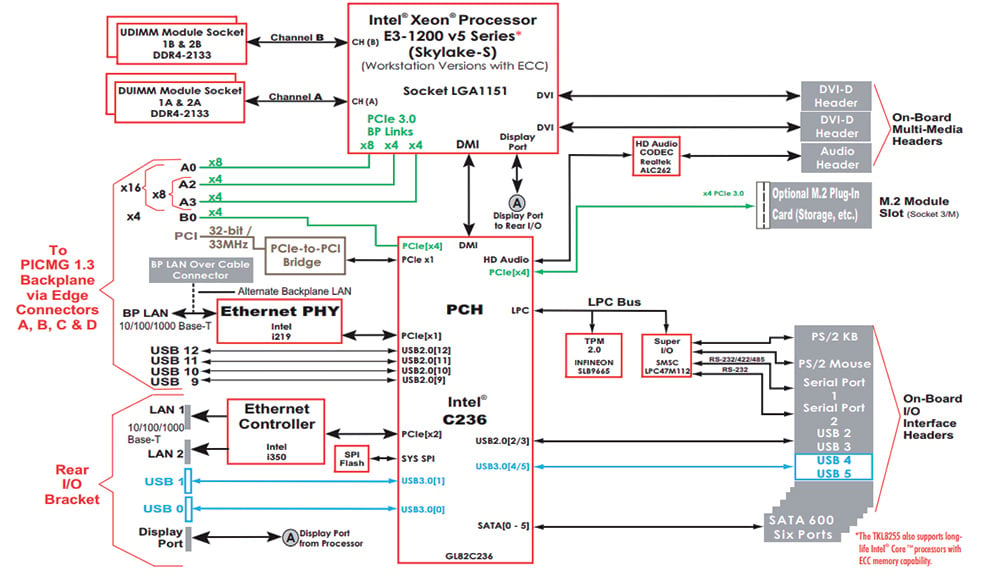
Standard Block Diagram Design for Trenton Systems' TKL8255 Processor Board, Used in the TMS4711 System
Design
The design phase follows the discussion and decision-making phase but is usually reserved for our customized rugged computing solutions.
Given that the TMS4711 system we're following is one of our common COTS systems, just minus a couple of components, we already had the processor board design, backplane design, chassis design, and system components necessary to assemble the system. So, this specific TMS4711 skips the design phase and goes directly to sub-assembly and assembly. Other TMS4711 orders may not, however, depending on the level of customization required by the customer.
Trenton Systems is known for designing rugged servers and workstations that don’t exist yet. In other words, our customers have the option of choosing standard solutions, which are based on common requests from our customers, or asking us to design a unique, never-before-seen system tailored to fit their program or application from the board up.
The departments and functions that are involved in the design phase depends on the components of a system that require customization. If a customer requests a custom BIOS, then software engineering takes the lead, but if they need a custom chassis, backplane, or processor board, mechanical, hardware or electrical engineering step up to the plate.
Naturally, given the high degree of customization that Trenton Systems offers its customers, Trenton’s electrical, mechanical, hardware and software engineering departments often work closely together to design a particular solution. This technical meeting of the minds often gives birth to new and exciting innovations in rugged computing. For example, we’ve designed a 5U rugged server with a front monitor, as well as a shelf-mount mini workstation, all because our customers desired ease of access and a small electronic footprint.
Our ability to design original, never-before-seen systems, coupled with the fact that our systems are designed, manufactured, assembled, integrated and supported in the USA, is what sets Trenton Systems apart. “The ‘however’ is where we shine” is one of our longstanding adages. In other words, we often meet with customers who say, “Well, we really like your 5U rugged server and your 4U rugged workstation; however, we need them to be black and silver, have front monitors, and be able to regularly withstand mechanical shock.”
You got it, boss.
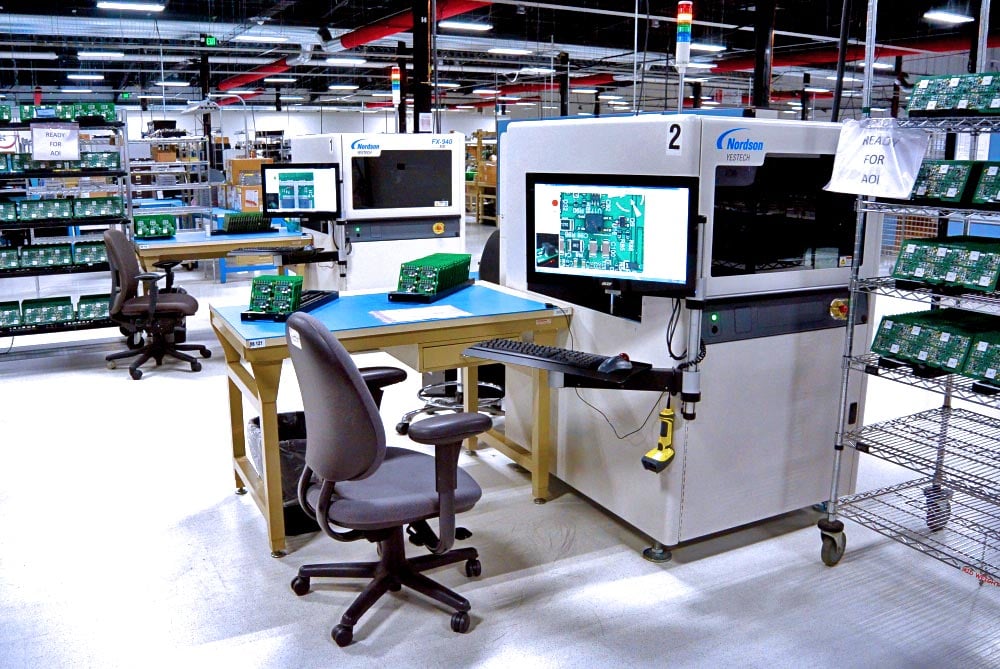
Photo: The interior of Trenton Technology, located in Utica, New York, and one of Trenton Systems' contract manufacturers
Manufacturing
Trenton Systems contracts with multiple USA manufacturers that supply us with boards, backplanes, chassis, CPU fans, memory, power supplies and other system components. Each of these components is manufactured stateside and ordered based on our designs, which are based on the wants and needs of our customers.
For example, say a customer likes our ION Mini PC but needs to add custom input/output options or make some size modifications to the system’s chassis. We’d design the blueprint for this system in-house, place an order for the components needed to build the system, and have them delivered to our facility in Lawrenceville, Georgia, where they’re stored in our massive inventory section for future sub-assembly, assembly, and testing.
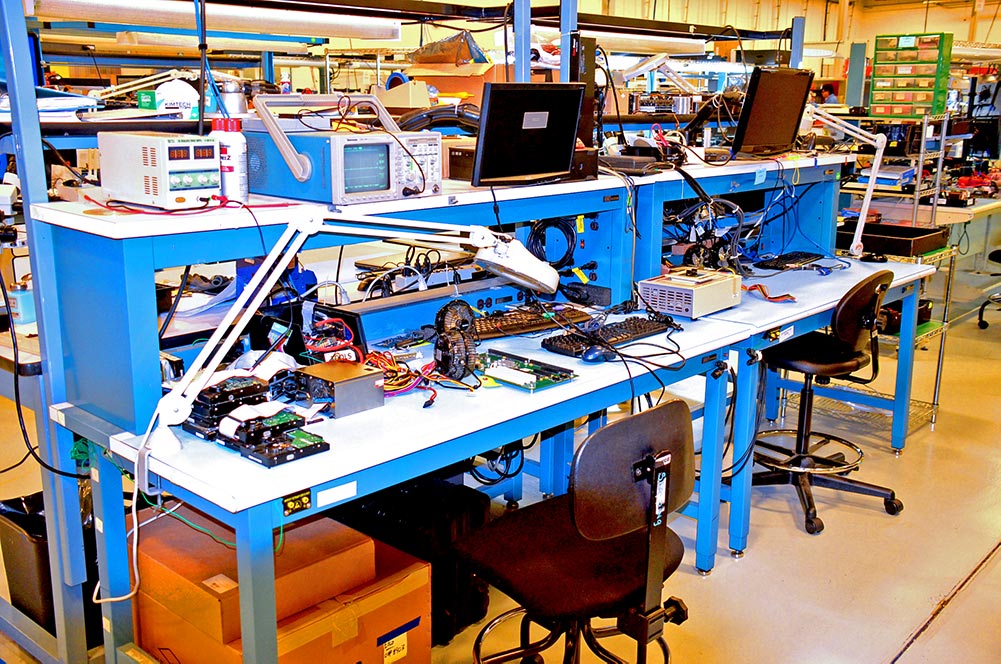
Photo: A portion of Trenton Systems' sub-assembly department, where processor boards, motherboards, and backplanes are assembled
Sub-Assembly & Assembly
Once Trenton Systems acquires the components necessary to build a system, it can begin the sub-assembly and assembly processes.
Sub-assembly of the motherboard or processor board is the first step. Components, such as the CPUs, RAM modules and heat sink, are gathered from our stock room and taken to sub-assembly, where they’re connected and tested by our technicians.
In the case of the TMS4711 we followed, the sub-assembly process saw the installation of the CPU and RAM modules onto the system's TKL8255 processor board. The BPG8155 backplane was also assembled.
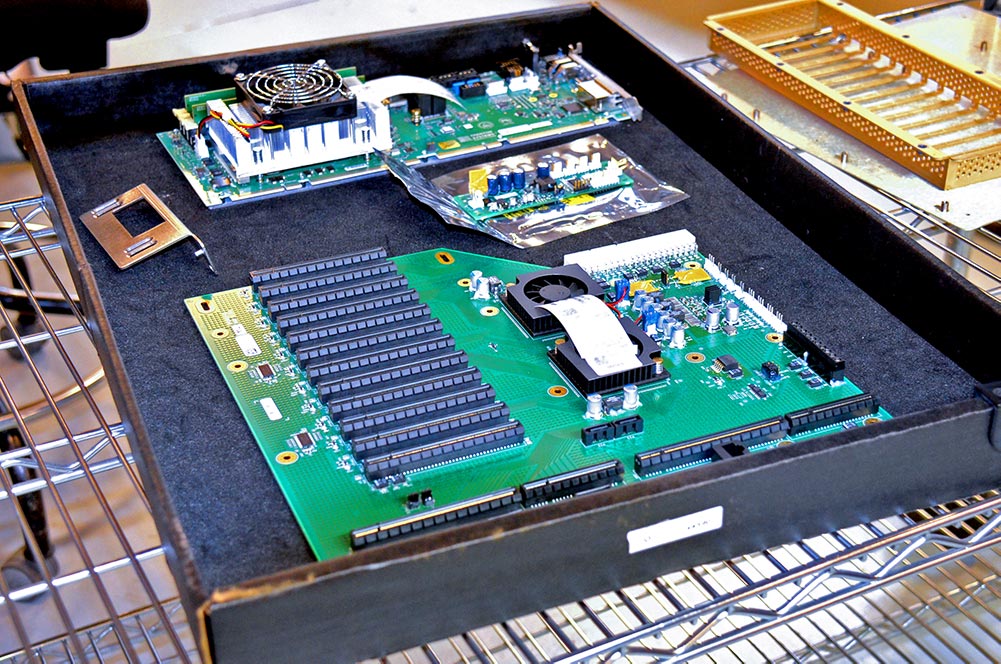
The TMS4711's TKL8255 Processor Board & BPG8155 PCIe Backplane
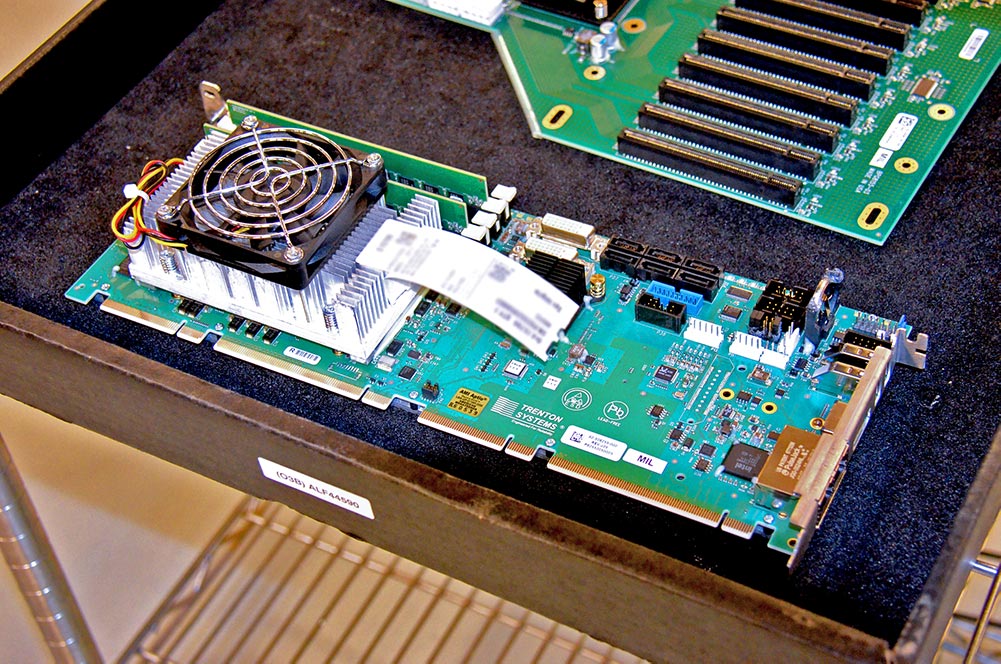
TKL8255 Processor Board
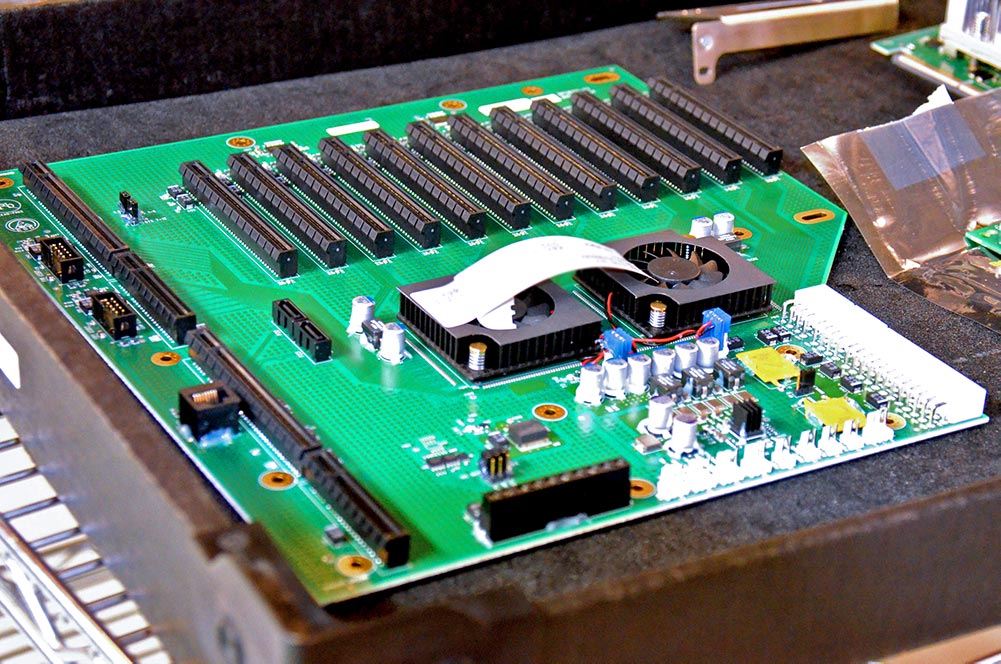
BPG8155 PCIe Backplane
From sub-assembly, the boards and backplanes are transported to assembly, where the boards, fans, power supplies, cables, PCIe backplane, and other components are inserted into the system’s chassis and connected to one another to form a complete system.
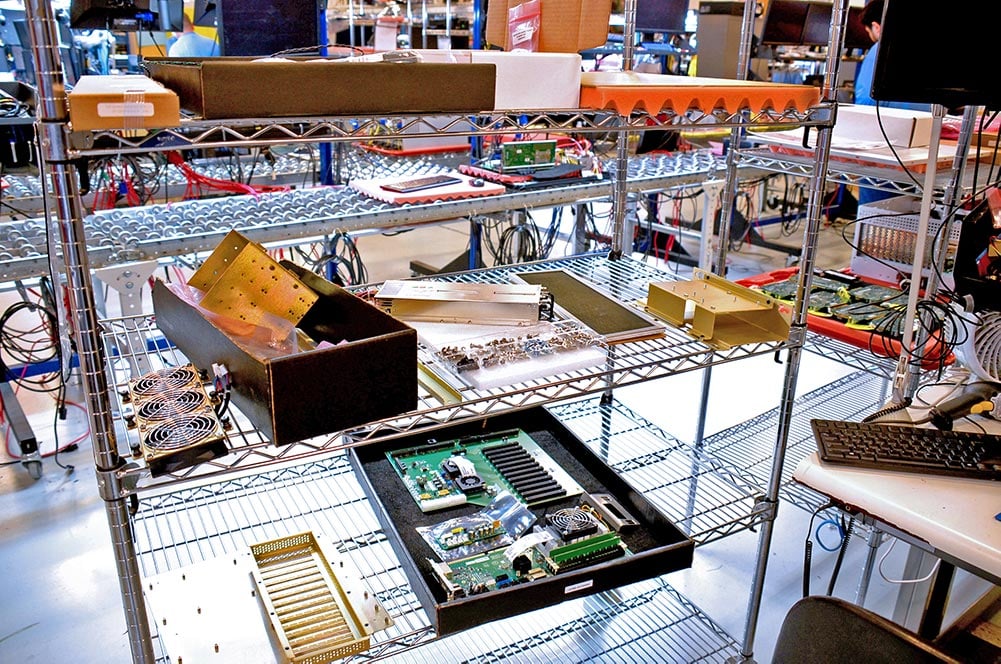
Sub-Assembly Rack with the TMS4711's Components
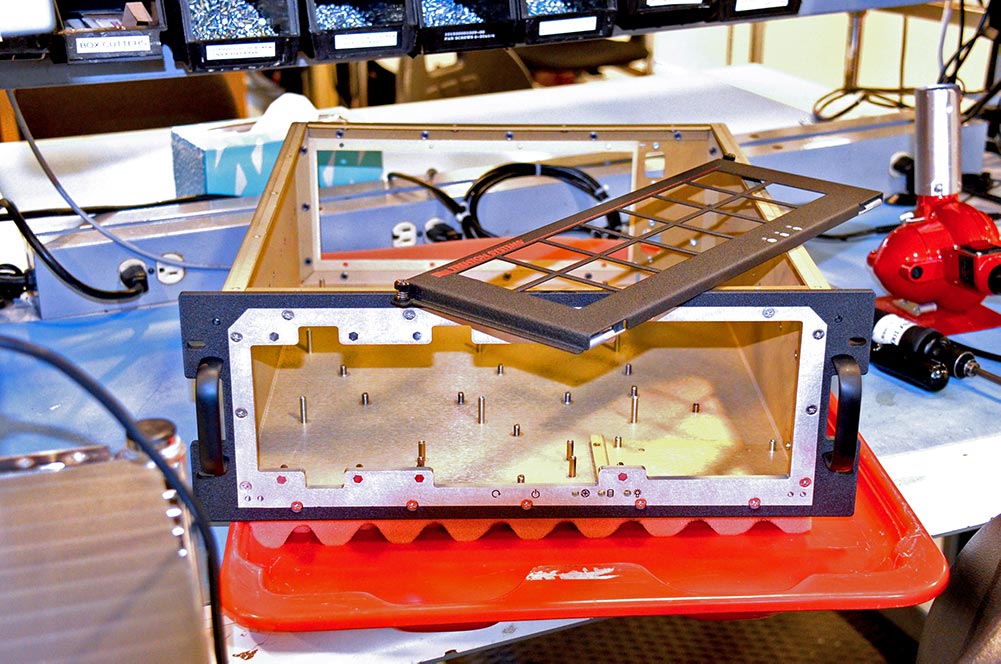
TMS4711 Chassis
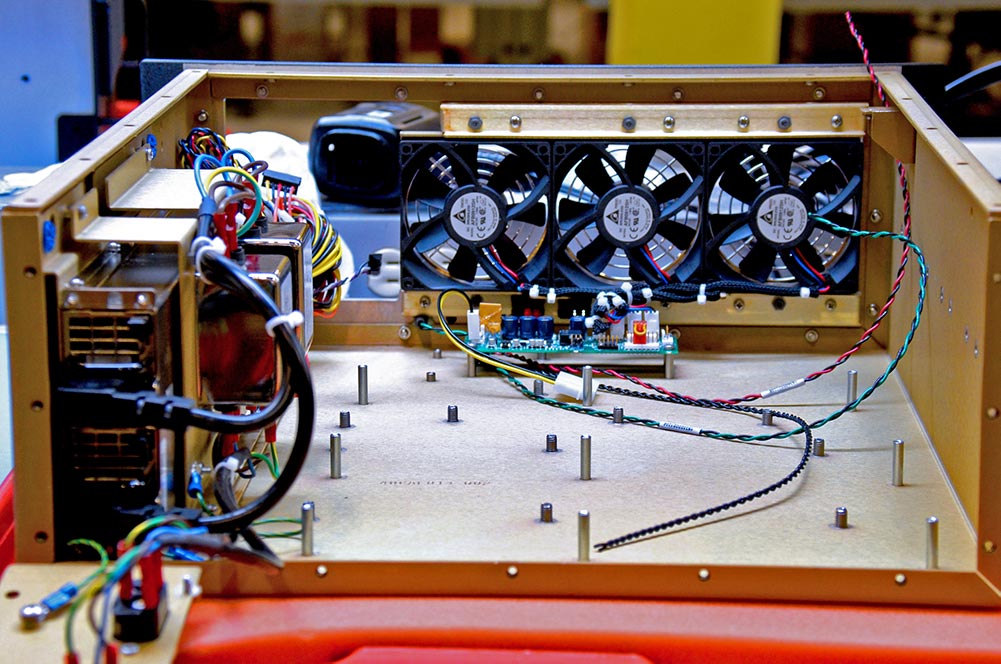
TMS4711 System Fans & Power Supply
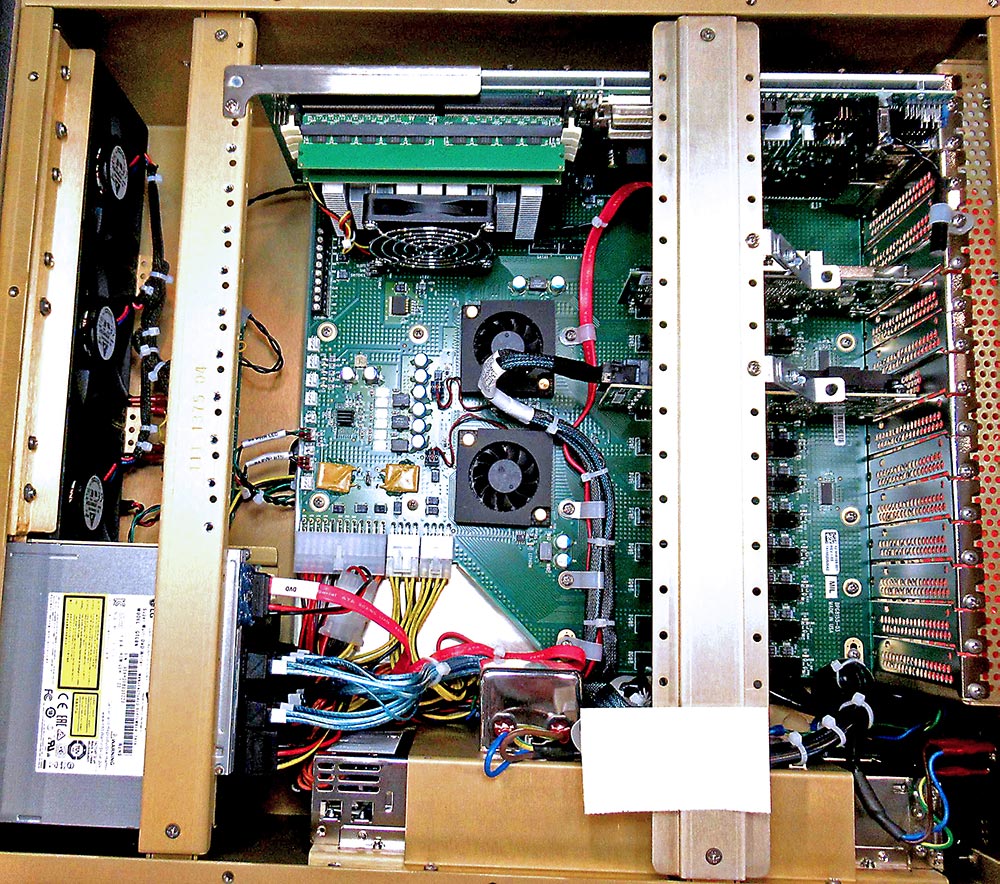
Interior View of the Integrated TMS4711
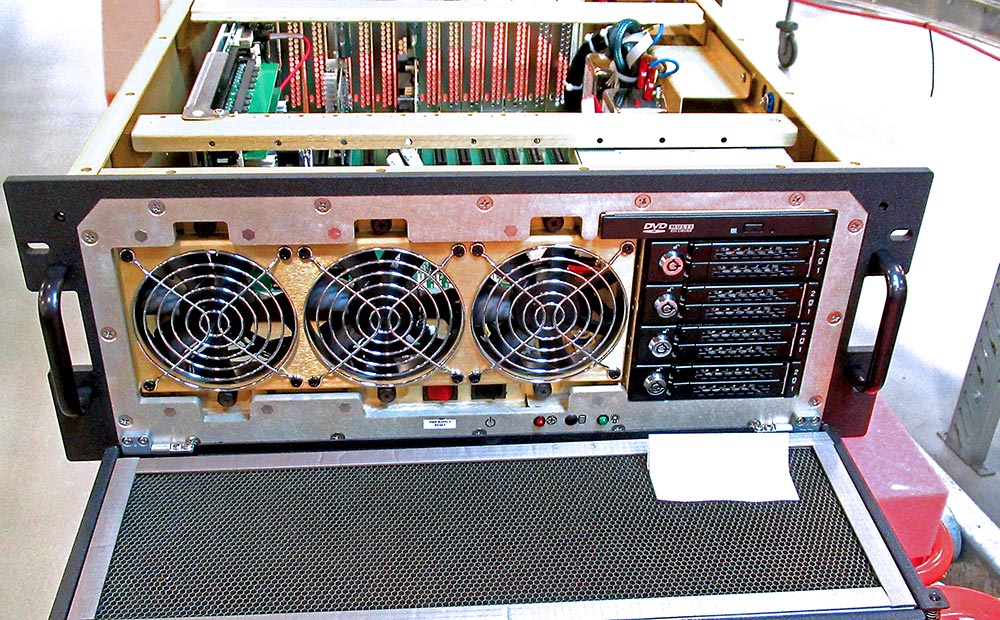
Completed TMS4711 System
Assembly is also the stage where we address any previously unforeseen system modifications. For example, we may need to redesign the system’s metalwork if we find that a specific component doesn’t fit neatly into the chassis. Nonetheless, once all modifications are implemented, assembly is where we finally achieve a fully functioning rugged computer.
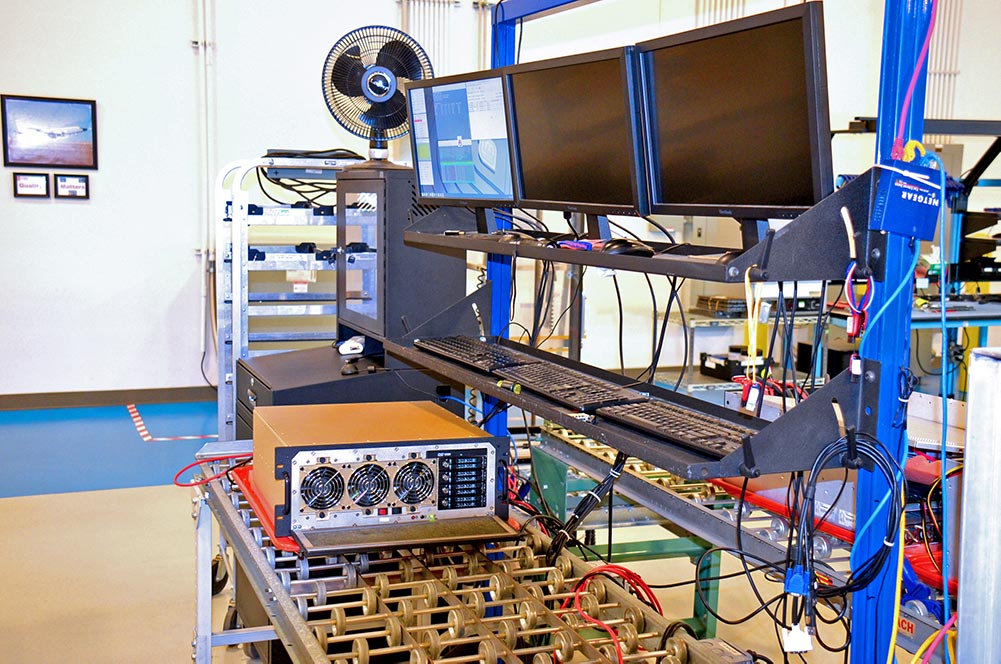
Photo: Trenton Systems' burn-in line, where we stress-test our systems before sending them to quality control
Testing & Ruggedization
Once the system is fully assembled, it’s typically sent through our burn-in line, unless the customer has requested any MIL-STD-810 or DO-160 shock and vibration testing. If that’s the case, the system goes directly to our in-house Uholtz-Dickey shock and vibe table.
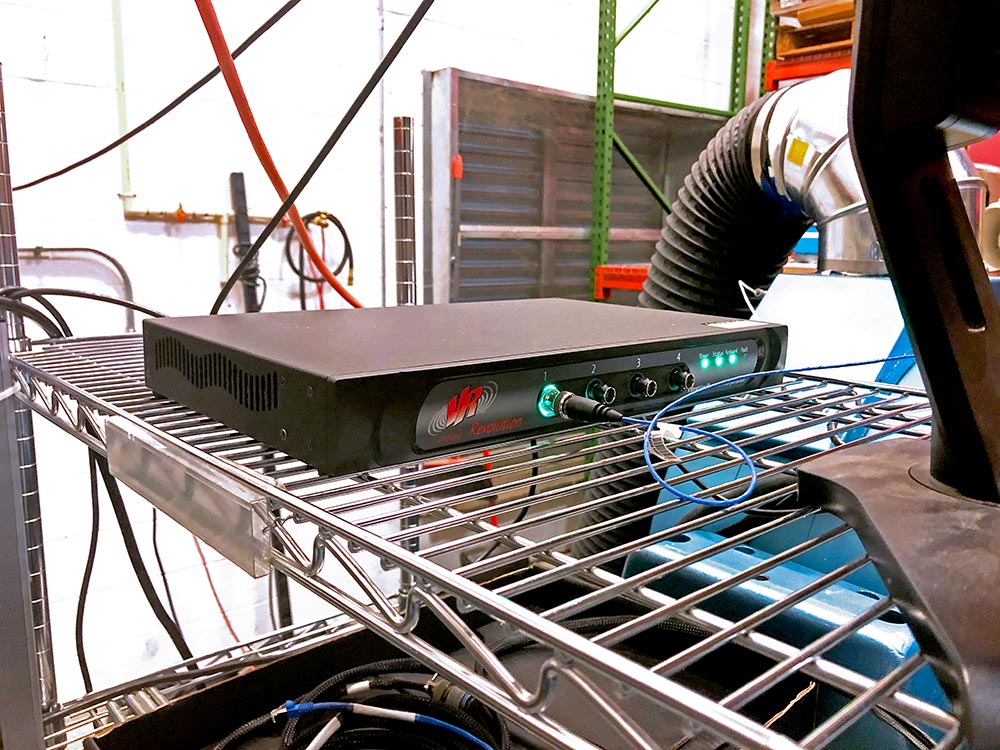
Vibration Research 9000 Controller
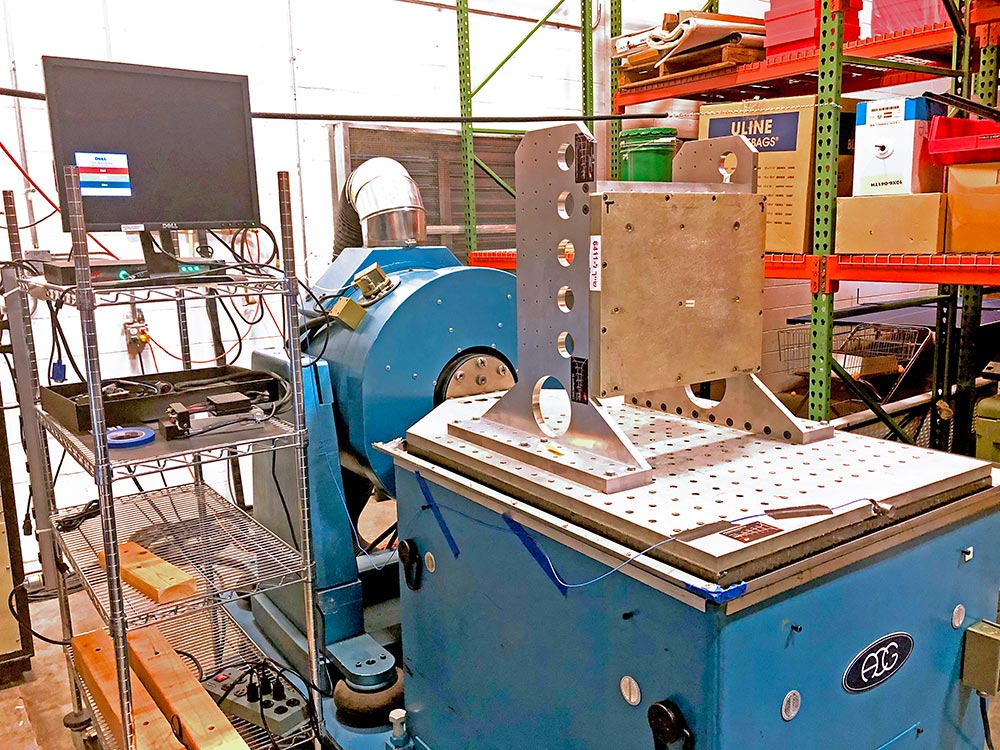
Uholtz-Dickey Shock & Vibration Table
Our test engineers use a state-of-the-art Vibration Research 9000 Controller to manage the table. The system is placed on the Uholtz-Dickey’s slip table in its operational state, and when testing begins, dispensed machine oil lubricates the table, causing it to float. Our test engineers then program the charts from DO-160 or MIL-STD-810 into the controller, set a timer and begin their assessments. The system is not only fully operational as it’s being vibrated and shocked, but the system is also being stress-tested to ensure optimal performance during similar, real-world conditions.
Vibrations range from 20-4,000 hertz, and between one and 20 shock pulses are typically administered. Most of the vibration tests take three hours to complete, one hour for each axis, while shock testing is an incredibly fast endeavor, as each pulse lasts just 11 milliseconds.
Unless something breaks or is dislodged, each test needs to be completed only once. Sometimes, a screw or a stud breaks or is dislodged, and that tells our test engineers that metalwork changes need to be made to the system to make it more durable. Breakage and dislodging of components rarely happen during testing, however. Our test engineers record the results, note any changes that need to be made, if any, and send the system to the next round of tests at the burn-in line.
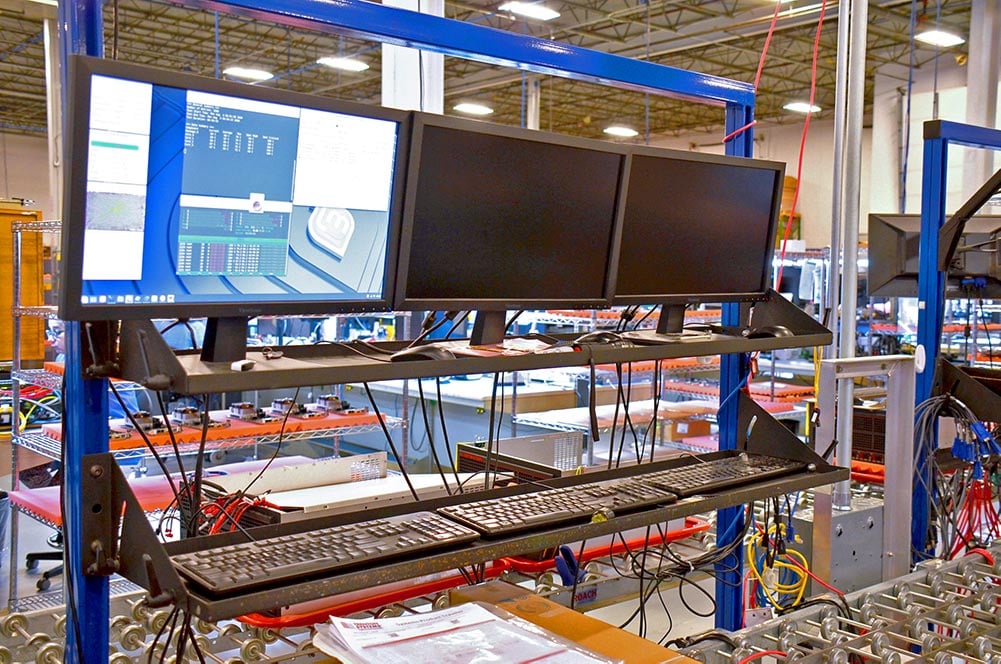
Burn-In Line Computers for Stress Testing
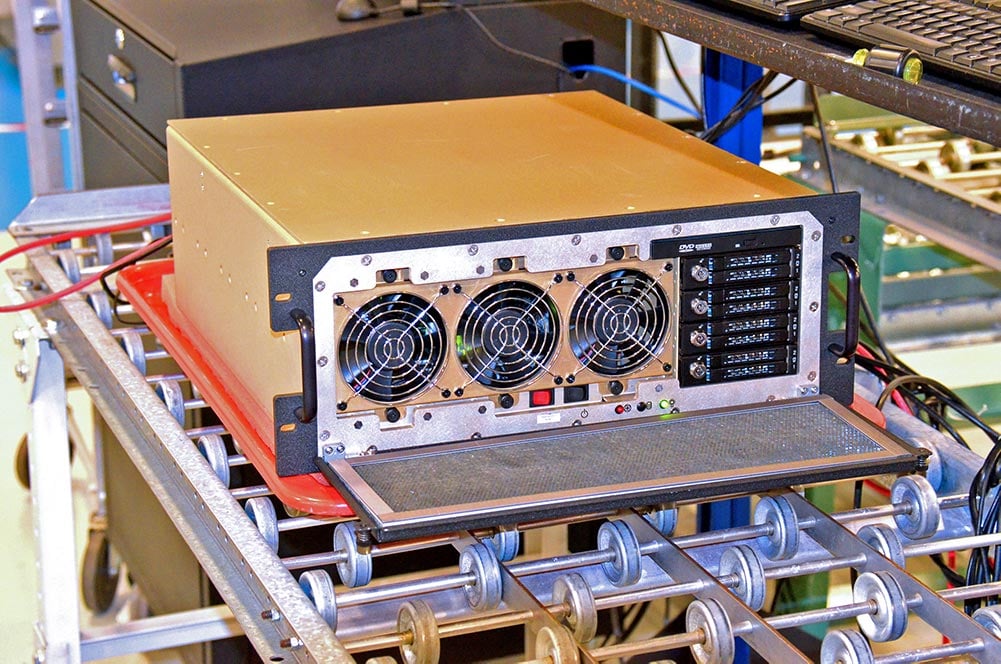
TMS4711 System on the Burn-In Line
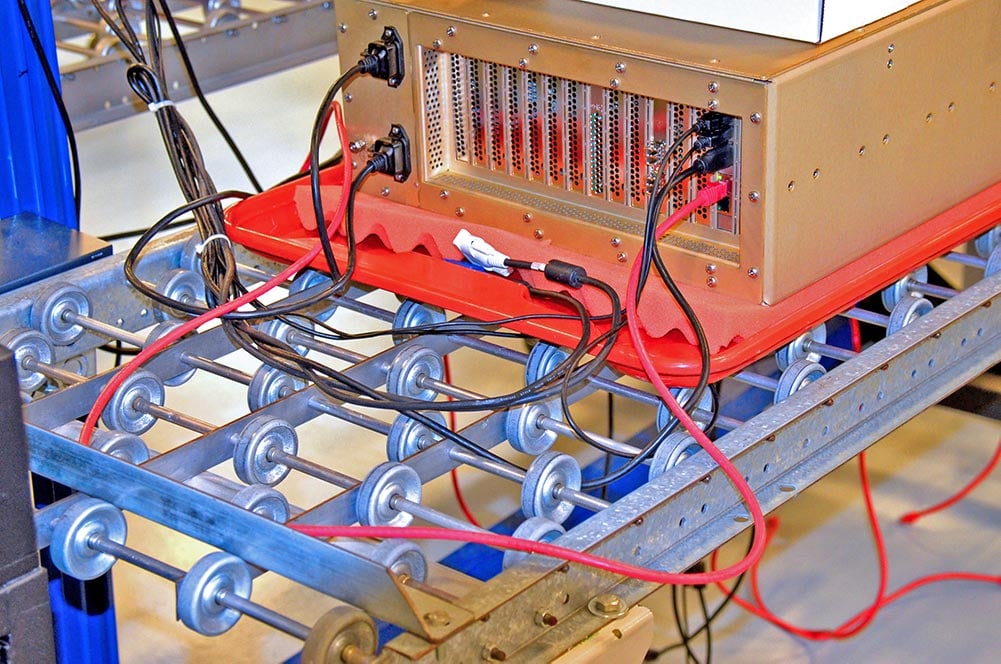
Rear View of the TMS4711 System on the Burn-In Line
The burn-in line is our bona fide stress test area. It’s where we max out the system’s CPUs and RAM modules for an extended period to ensure that they don’t overheat or fail while running resource-intensive applications during a mission-critical operation.
Burn-in also covers the Pre-Boot Execution Environment (PXE) process, determines whether the system’s fans are providing adequate cooling, whether the fan controllers are working properly, whether the hard drive or solid-state drive is ready to be written to and read, whether the system’s input/out ports are functioning, and much more.
Burn-in typically lasts four hours. Most system errors will occur within the first hour of operation, but we stress the system for an additional three hours just in case.
Once the system has received its final health assessment on the burn-in line, it’s sent to software engineering for operating system installation before finally being sent to quality control for a pre-shipment inspection. If the customer wishes to install their own OS, however, the system is sent directly to quality for final inspection.
There could be a slight deviation in the process after burn-in, however. If a customer requests temperature or humidity testing, the system is sent to our Thermotron testing chamber, where, based on our own in-house standards, MIL-STD-810, DO-160 or any other standards specified by the customer, it’s tested for resistance to high humidity and extreme temperatures for days at a time. Once environmental testing is complete, the system is tested for functionality and sent to quality control.
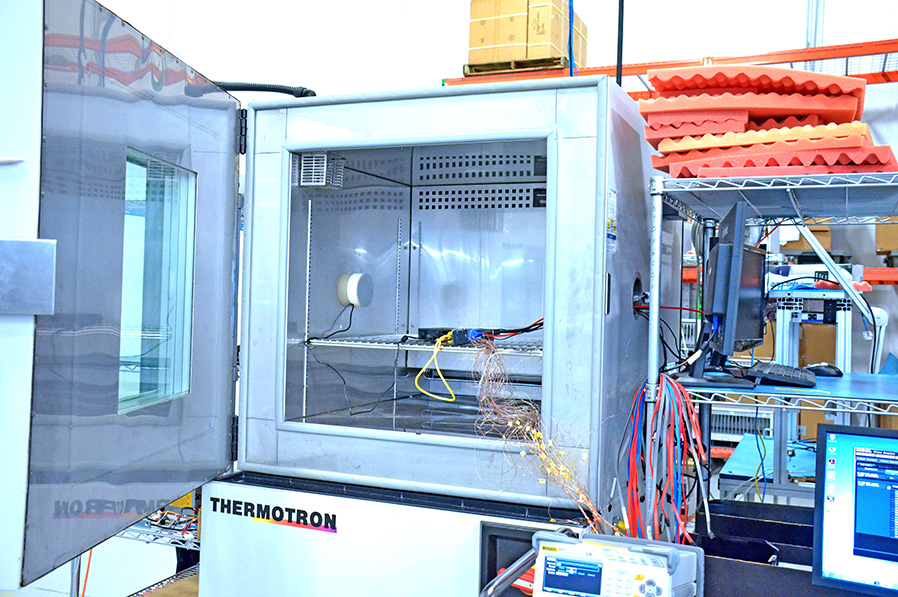
Thermotron Environmental Testing Chamber
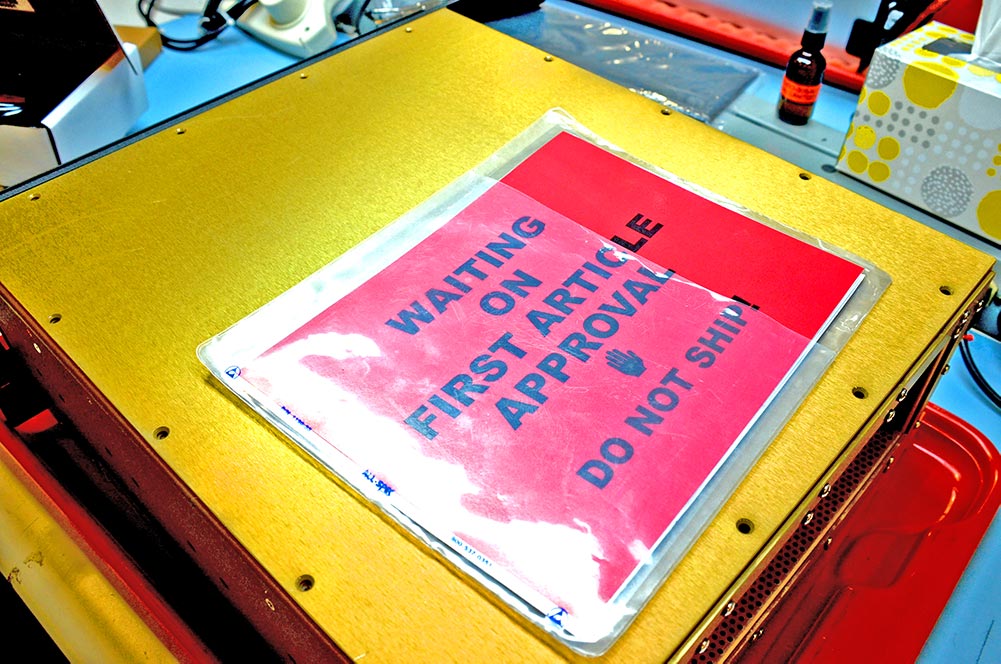
Quality Control's First Article Inspection of the TMS4711 System
Quality & Shipment
To be clear, quality control measures are implemented at every step of the manufacturing process. Our products receive an inspection and correspondence review prior to the start of each step to ensure that the responsibilities associated with the previous step were completed. If a step is flagged as incomplete, the system is sent back to the previous department for completion or further review.
Assuming all responsibilities were completed in the previous steps and quality was maintained, the system will be sent to quality control after burn-in or environmental testing for its final, pre-shipment inspection. All newly manufactured products and software are required to undergo a 100-percent inspection and photographing prior to being shipped to the customer.
In addition, a cosmetic inspection is performed to ensure adherence to predefined quality procedures, and the product is verified against the sales order or packing slip to ensure that all components, documentation, labels, serial numbers and revision levels are correct.
Once the system is approved by quality, it's packaged, weighed, and shipped to the customer from shipping and receiving.
Happy rugged computing!
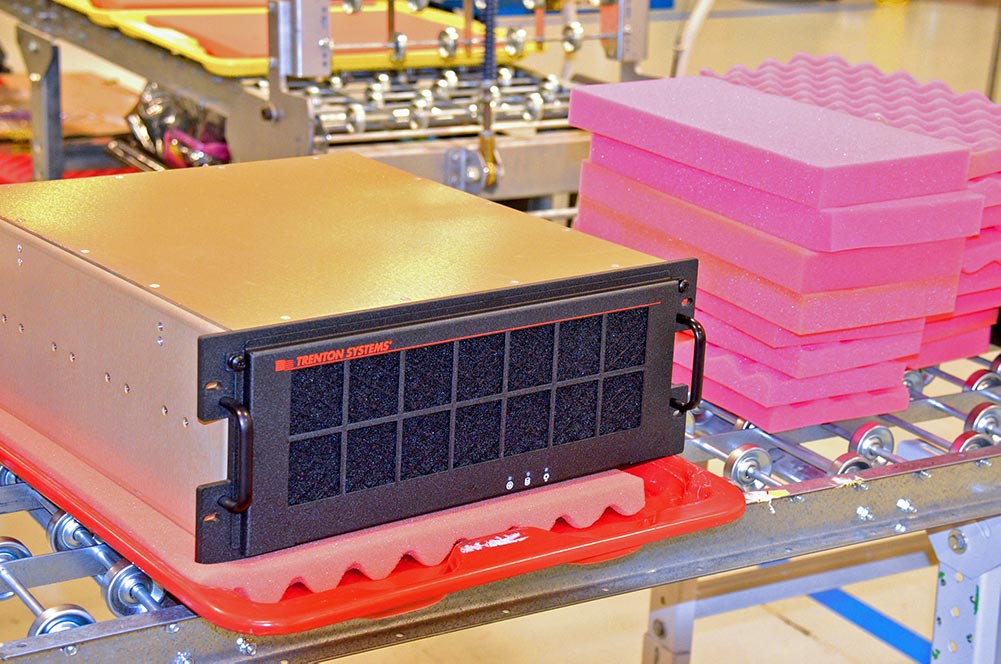
The Finished TMS4711 System Situated on the Shipping Belt
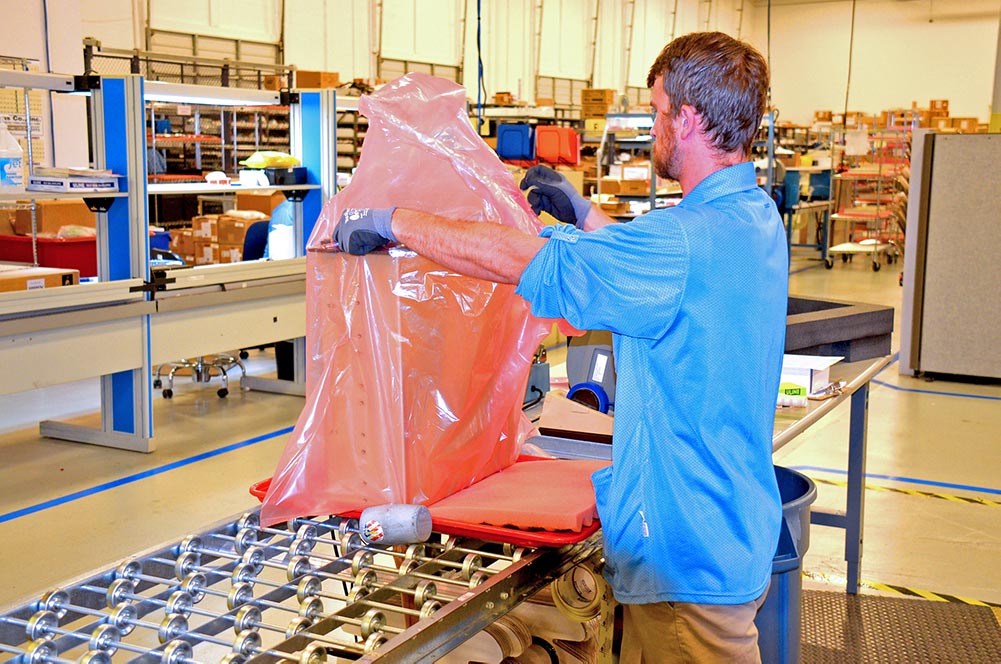
A Trenton Systems Employee Packages the TMS4711 System
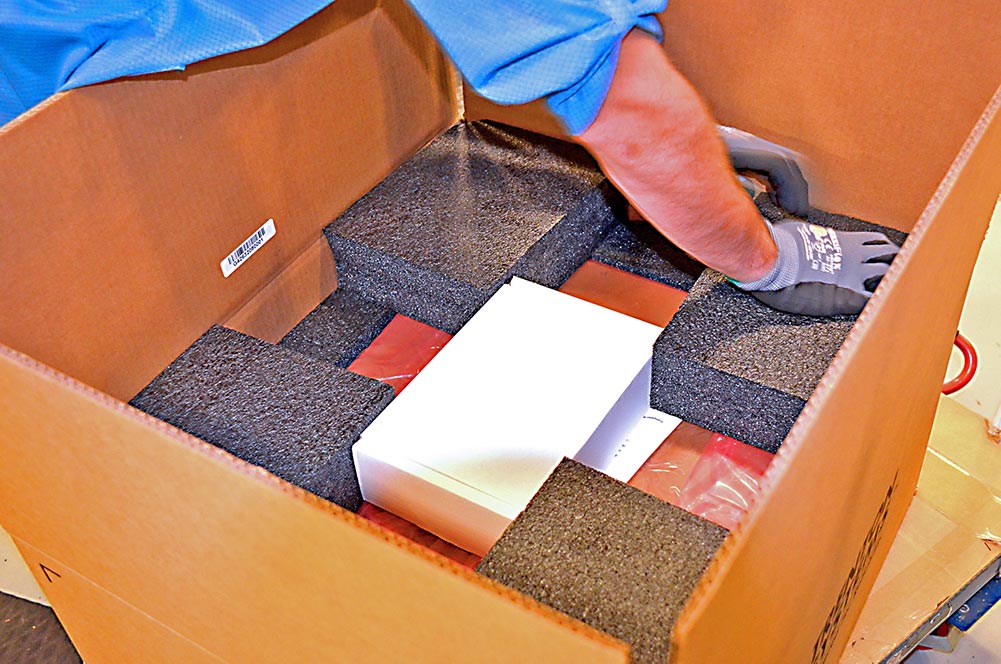
The TMS4711 System is Placed Into a Shipping Box and Packed with Foam
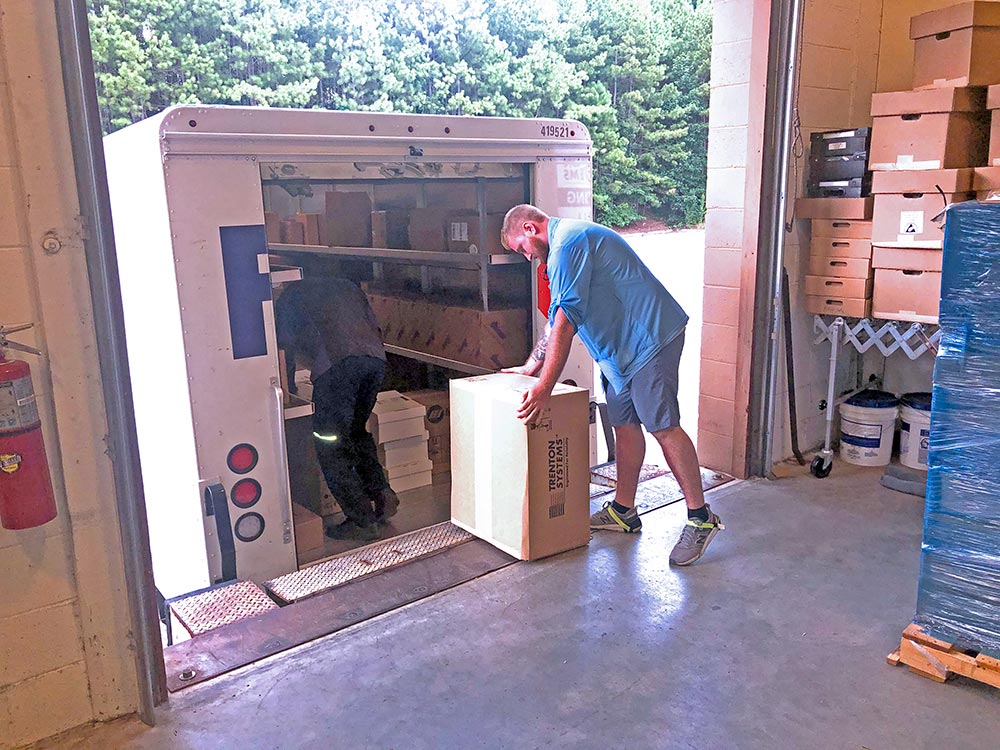
A Trenton Systems Employee Loads the TMS4711 System Onto the Delivery Truck
Support
Trenton Systems offers limited lifetime support and a five-year warranty for each of its systems. This includes:
- Revision control
- End-of-life notices
- Hardware and software troubleshooting
- Repairs and replacements
- Custom BIOS assistance
- Answers to technical questions
- Access to our support team during your loaner period
For more information about our support options and worry-free warranty, visit Trenton Systems’ Support and Services pages.
Conclusion
We hope you enjoyed this inside look at our production process. It's important to remember that every system's journey through production is different. The TMS4711 we followed is merely a typical example.
Are you ready to experience the Trenton Systems difference?
Share this
- High-performance computers (42)
- Military computers (38)
- Rugged computers (32)
- Cybersecurity (25)
- Industrial computers (25)
- Military servers (24)
- MIL-SPEC (20)
- Rugged servers (19)
- Press Release (17)
- Industrial servers (16)
- MIL-STD-810 (16)
- 5G Technology (14)
- Intel (13)
- Rack mount servers (12)
- processing (12)
- Computer hardware (11)
- Edge computing (11)
- Rugged workstations (11)
- Made in USA (10)
- Partnerships (9)
- Rugged computing (9)
- Sales, Marketing, and Business Development (9)
- Trenton Systems (9)
- networking (9)
- Peripheral Component Interconnect Express (PCIe) (7)
- Encryption (6)
- Federal Information Processing Standards (FIPS) (6)
- GPUs (6)
- IPU (6)
- Joint All-Domain Command and Control (JADC2) (6)
- Server motherboards (6)
- artificial intelligence (6)
- Computer stress tests (5)
- Cross domain solutions (5)
- Mission-critical servers (5)
- Rugged mini PCs (5)
- AI (4)
- BIOS (4)
- CPU (4)
- Defense (4)
- Military primes (4)
- Mission-critical systems (4)
- Platform Firmware Resilience (PFR) (4)
- Rugged blade servers (4)
- containerization (4)
- data protection (4)
- virtualization (4)
- Counterfeit electronic parts (3)
- DO-160 (3)
- Edge servers (3)
- Firmware (3)
- HPC (3)
- Just a Bunch of Disks (JBOD) (3)
- Leadership (3)
- Navy (3)
- O-RAN (3)
- RAID (3)
- RAM (3)
- Revision control (3)
- Ruggedization (3)
- SATCOM (3)
- Storage servers (3)
- Supply chain (3)
- Tactical Advanced Computer (TAC) (3)
- Wide-temp computers (3)
- computers made in the USA (3)
- data transfer (3)
- deep learning (3)
- embedded computers (3)
- embedded systems (3)
- firmware security (3)
- machine learning (3)
- Automatic test equipment (ATE) (2)
- C6ISR (2)
- COTS (2)
- COVID-19 (2)
- CPUs (2)
- Compliance (2)
- Compute Express Link (CXL) (2)
- Computer networking (2)
- Controlled Unclassified Information (CUI) (2)
- DDR (2)
- DDR4 (2)
- DPU (2)
- Dual CPU motherboards (2)
- EW (2)
- I/O (2)
- Military standards (2)
- NVIDIA (2)
- NVMe SSDs (2)
- PCIe (2)
- PCIe 4.0 (2)
- PCIe 5.0 (2)
- RAN (2)
- SIGINT (2)
- SWaP-C (2)
- Software Guard Extensions (SGX) (2)
- Submarines (2)
- Supply chain security (2)
- TAA compliance (2)
- airborne (2)
- as9100d (2)
- chassis (2)
- data diode (2)
- end-to-end solution (2)
- hardware security (2)
- hardware virtualization (2)
- integrated combat system (2)
- manufacturing reps (2)
- memory (2)
- mission computers (2)
- private 5G (2)
- protection (2)
- secure by design (2)
- small form factor (2)
- software security (2)
- vRAN (2)
- zero trust (2)
- zero trust architecture (2)
- 3U BAM Server (1)
- 4G (1)
- 4U (1)
- 5G Frequencies (1)
- 5G Frequency Bands (1)
- AI/ML/DL (1)
- Access CDS (1)
- Aegis Combat System (1)
- Armed Forces (1)
- Asymmetric encryption (1)
- C-RAN (1)
- COMINT (1)
- Cloud-based CDS (1)
- Coast Guard (1)
- Compliance testing (1)
- Computer life cycle (1)
- Containers (1)
- D-RAN (1)
- DART (1)
- DDR5 (1)
- DMEA (1)
- Data Center Modular Hardware System (DC-MHS) (1)
- Data Plane Development Kit (DPDK) (1)
- Defense Advanced Research Projects (DARP) (1)
- ELINT (1)
- EMI (1)
- EO/IR (1)
- Electromagnetic Interference (1)
- Electronic Warfare (EW) (1)
- FIPS 140-2 (1)
- FIPS 140-3 (1)
- Field Programmable Gate Array (FPGA) (1)
- Ground Control Stations (GCS) (1)
- Hardware-based CDS (1)
- Hybrid CDS (1)
- IES.5G (1)
- ION Mini PC (1)
- IP Ratings (1)
- IPMI (1)
- Industrial Internet of Things (IIoT) (1)
- Industry news (1)
- Integrated Base Defense (IBD) (1)
- LAN ports (1)
- LTE (1)
- Life cycle management (1)
- Lockheed Martin (1)
- MIL-S-901 (1)
- MIL-STD-167-1 (1)
- MIL-STD-461 (1)
- MIL-STD-464 (1)
- MOSA (1)
- Multi-Access Edge Computing (1)
- NASA (1)
- NIC (1)
- NIC Card (1)
- NVMe (1)
- O-RAN compliant (1)
- Oil and Gas (1)
- Open Compute Project (OCP) (1)
- OpenRAN (1)
- P4 (1)
- PCIe card (1)
- PCIe lane (1)
- PCIe slot (1)
- Precision timestamping (1)
- Product life cycle (1)
- ROM (1)
- Raytheon (1)
- Remotely piloted aircraft (RPA) (1)
- Rugged computing glossary (1)
- SEDs (1)
- SIM Card (1)
- Secure boot (1)
- Sensor Open Systems Architecture (SOSA) (1)
- Small form-factor pluggable (SFP) (1)
- Smart Edge (1)
- Smart NIC (1)
- SmartNIC (1)
- Software-based CDS (1)
- Symmetric encryption (1)
- System hardening (1)
- System hardening best practices (1)
- TME (1)
- Tech Partners (1)
- Total Memory Encryption (TME) (1)
- Transfer CDS (1)
- USB ports (1)
- VMEbus International Trade Association (VITA) (1)
- Vertical Lift Consortium (VLC) (1)
- Virtual machines (1)
- What are embedded systems? (1)
- Wired access backhaul (1)
- Wireless access backhaul (1)
- accredidation (1)
- aerospace (1)
- air gaps (1)
- airborne computers (1)
- asteroid (1)
- authentication (1)
- autonomous (1)
- certification (1)
- cognitive software-defined radios (CDRS) (1)
- command and control (C2) (1)
- communications (1)
- cores (1)
- custom (1)
- customer service (1)
- customer support (1)
- data linking (1)
- data recording (1)
- ethernet (1)
- full disk encryption (1)
- hardware monitoring (1)
- heat sink (1)
- hypervisor (1)
- in-house technical support (1)
- input (1)
- integrated edge solution (1)
- international business (1)
- licensed spectrum (1)
- liquid cooling (1)
- mCOTS (1)
- microelectronics (1)
- missile defense (1)
- mixed criticality (1)
- moving (1)
- multi-factor authentication (1)
- network slicing (1)
- neural networks (1)
- new headquarters (1)
- next generation interceptor (1)
- non-volatile memory (1)
- operating system (1)
- output (1)
- outsourced technical support (1)
- post-boot (1)
- pre-boot (1)
- private networks (1)
- public networks (1)
- radio access network (RAN) (1)
- reconnaissance (1)
- rugged memory (1)
- secure flash (1)
- security (1)
- self-encrypting drives (SEDs) (1)
- sff (1)
- software (1)
- software-defined radios (SDRs) (1)
- speeds and feeds (1)
- standalone (1)
- storage (1)
- systems (1)
- tactical wide area networks (1)
- technical support (1)
- technology (1)
- third-party motherboards (1)
- troposcatter communication (1)
- unlicensed spectrum (1)
- volatile memory (1)
- vpx (1)
- zero trust network (1)
- January 2025 (1)
- November 2024 (1)
- October 2024 (1)
- August 2024 (1)
- July 2024 (1)
- May 2024 (1)
- April 2024 (3)
- February 2024 (1)
- November 2023 (1)
- October 2023 (1)
- July 2023 (1)
- June 2023 (3)
- May 2023 (7)
- April 2023 (5)
- March 2023 (7)
- December 2022 (2)
- November 2022 (6)
- October 2022 (7)
- September 2022 (8)
- August 2022 (3)
- July 2022 (4)
- June 2022 (13)
- May 2022 (10)
- April 2022 (4)
- March 2022 (11)
- February 2022 (4)
- January 2022 (4)
- December 2021 (1)
- November 2021 (4)
- September 2021 (2)
- August 2021 (1)
- July 2021 (2)
- June 2021 (3)
- May 2021 (4)
- April 2021 (3)
- March 2021 (3)
- February 2021 (8)
- January 2021 (4)
- December 2020 (5)
- November 2020 (5)
- October 2020 (4)
- September 2020 (4)
- August 2020 (6)
- July 2020 (9)
- June 2020 (11)
- May 2020 (13)
- April 2020 (8)
- February 2020 (1)
- January 2020 (1)
- October 2019 (1)
- August 2019 (2)
- July 2019 (2)
- March 2019 (1)
- January 2019 (2)
- December 2018 (1)
- November 2018 (2)
- October 2018 (5)
- September 2018 (3)
- July 2018 (1)
- April 2018 (2)
- March 2018 (1)
- February 2018 (9)
- January 2018 (27)
- December 2017 (1)
- November 2017 (2)
- October 2017 (3)
/Trenton%20Systems%20Circular%20Logo-3.png?width=50&height=50&name=Trenton%20Systems%20Circular%20Logo-3.png)

No Comments Yet
Let us know what you think